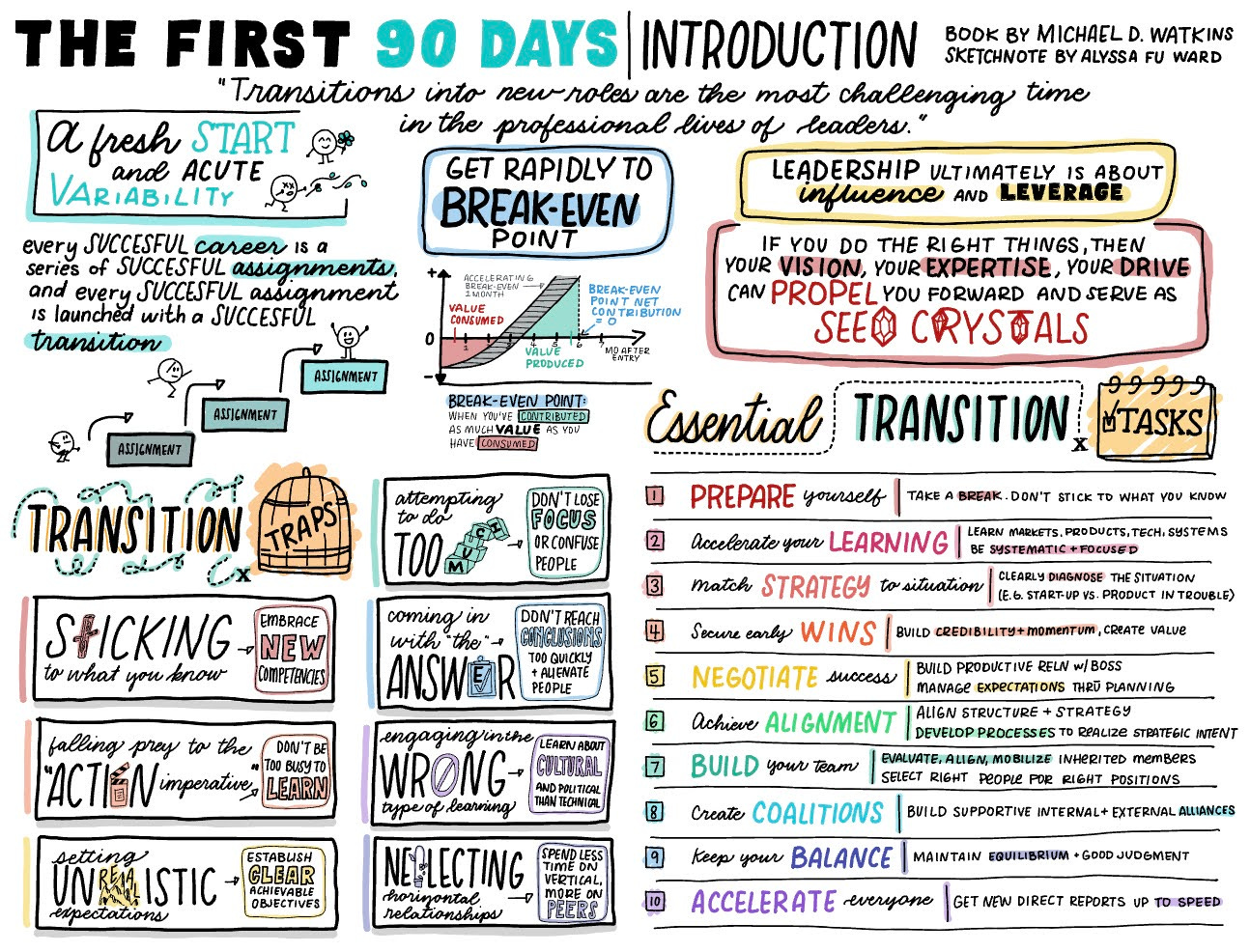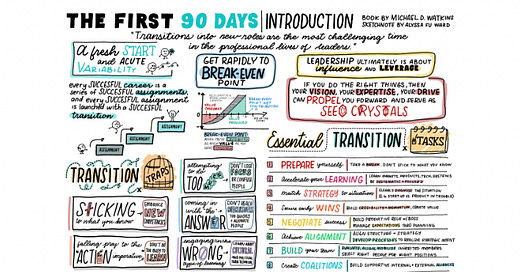The First 90 Days (Intro): The twists and turns of transitions
Navigating work transitions is like traveling to a new culture

Nearly any time I started a new role, someone would recommend I read The First 90 Days. I always meant to, but it wasn’t until after a particularly difficult transition that I finally picked it up. Instead of referring to it as a guidebook, I used it for a postmortem. On every page, I shook my head, wishing my past self had seen these ideas earlier.
I started documenting the book’s insights in sketchnotes. The first one, shared above, summarizes the introduction. As I created this note, I reflected on my experiences with transitions. I share some of these thoughts below.
I have a blindspot when it comes to transitions. It’s because I love them! I tend to run into new situations with barely controlled excitement. I can’t wait to jump into a fresh start, meet new people, and absorb new ideas and ways of doing things.
I forget about the dips and dives that come with entering a new environment, that much of what I assume to be the “right” way to behave, talk, and even think will be challenged. The challenge doesn’t have to come from malice or even another person. It comes from the double-sided nature of learning.
Learning can be a gateway to expanding the self, especially when the new knowledge and experiences build on what we know about ourselves and our strengths. We may realize we need to question our previously held assumptions, but old beliefs are easy to cast aside when the new ones are a shiny continuation of what we used to believe.
Learning can also be a swirling mass of chaos, especially when those new ideas and situations push against what we believe is true. One sign of this is when we say something in a meeting that we expect to be welcomed with praise and encouragement but is met with blank stares or direct pushback. This surprising situation can kick off a vicious cycle where we want to dig in our heels to hold on to what we knew to be true, and mutual resistance starts to feed on itself. Sometimes, to manage a transition, learning requires breaking ourselves down a little so we can make room to integrate new ideas.
Some transitions are striking. For example, when you travel to a new country, the unfamiliar features of the new setting crash over your senses from the moment you step off the plane. Buildings take a different form, the air smells of unfamiliar weather and strange food, people may bow in greeting instead of saying hello. You may experience confusion, but there’s a ready explanation for it. And sometimes that confusion can turn into amusement or even connection, as you learn more about how the new culture works in contrast to your own.

When you enter a new work environment, it’s much like arriving in a new culture. There may not be tarmac, and the food is unlikely to cause bewilderment, but there are still new practices, norms, and expectations to navigate.
Unlike landing in a new country, however, cultural differences across workplaces and roles lurk beneath the surface. Potential clashes are harder to spot, and the stakes are high to sidestep them with confidence.
There are rarely colorful travel guides to explain to new hires all the implicit cultural knowledge they need in order to successfully assimilate into a new workplace. Some unknowns are obvious and easy to ask about - idiosyncratic terminology or formal work processes. Many unknowns are disguised and sticky, even to the people already in the work environment - unspoken rules, complicated relationships and motives, and informal ways of working. When you experience confusion, it can be hard to disentangle why. Unresolved confusion can turn into frustration and blame, which spiral inward toward yourself and twist back out toward others.
The First 90 Days provides useful frameworks to diagnose this confusion and move forward with a structured plan. Their emphasis is that successful transitions aren’t just about acquiring technical knowledge. They rely heavily on navigating the particular explicit and implicit cultural and political patterns of the new situation.
For me, these ideas are about to go from theoretical to practical. I’m on a diving board staring down into the murky pool of a new work experience. This time, I plan to keep The First 90 Days close as a proper reference.

After collecting some bumps and bruises, my transition blind spot is no longer hidden behind unbridled enthusiasm. Now it’s partially exposed, and light apprehension is peeking through. I’ll still hold on to my excitement and hunger to learn, but I’ll move slower so I can intentionally assess new situations.
When I experience confusion, I’ll practice drawing on curiosity instead of frustration. When I make quick conclusions, I’ll try to pause and ask myself what I could be missing.
I’ll put my best self out there based on ideas I have accessible to me at that time, and I’ll learn from what comes back. And when I feel the uncertainty that comes from taking on a new challenge start to creep over my shoulder, I’ll take comfort in knowing I can’t control the unknown.





Very useful ideas during transition!